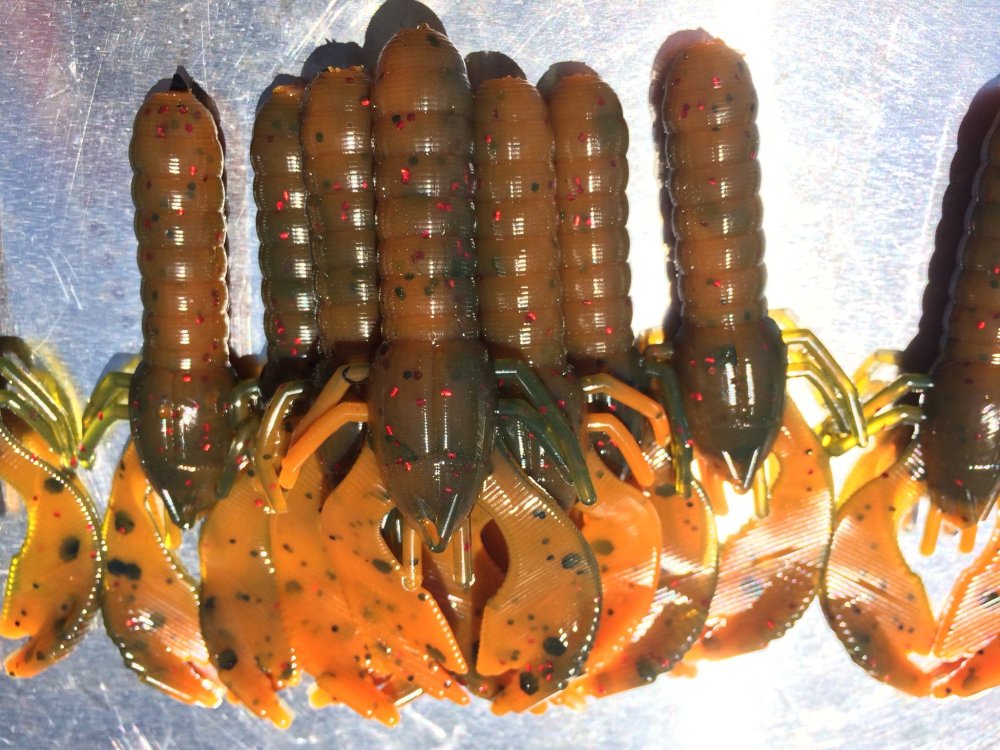-
Posts
1,379 -
Joined
-
Last visited
-
Days Won
61
Content Type
Profiles
Articles
TU Classifieds
Glossary
Website Links
Forums
Gallery
Store
Everything posted by Apdriver
-
A little of this pixy dust goes a long way, Mark. Instead of trying to use a carrier, have you tried to brush it on your mold and see how it works?
-
Good advise on the pot, I’d say. Without knowing the source and history of the lead weights, you might want to melt and flux your lead before putting it your pot. Gulf paraffin wax from your grocery store is a good flux that is readily available. Done correctly, it will smoke, possibly catch fire so do it outside and stay upwind. Wear boots, gloves, long sleeves, don’t drink and keep kids, pets, over enthusiastic girlfriends, etc. away. Stir it while the flux melts and catches fire. Long handled stainless steel or if you have some good hickory from your carpenter days that will do too. It will burn some but that’s OK it’s a good flux too. After all the flux has burned away, skim the dross (the impurities) that rise to the top off with a long handled stainless spoon. If your spoon melts, it’s not stainless. Don’t ask me how I know. Explore some different opinions and sources for your lead. Might do a search here as we have discussed it many times. Read the safety dos and don’ts pinned at the top. Above all, enjoy.
-
Typical of the Lee pot. You need to clean out the spout as some contaminants have made their way or it may even be oxidation. I always place a small Pyrex cup under the spout to catch the lead coming out when I do this. Wear gloves to protect yourself. After it heats up, take some wire or a hook bent in a 90 to keep you out of harms way and probe the hole. Open the spout and probe. This will loosen the oxidation-debris and should fix you back up. Always keep a catch pan under that Lee when heating it up. Saves some aggravation as it always will drip some. Shouldn’t pour out though. This is just how I do it.
-
Here’s the hilites. They can be added right in your plastisol or brushed on and clear dipped. https://www.lurepartsonline.com/6833-LureCraft-Super-Hi-Lite-Pigment?quantity=1&custcol_beads_eyes_paint_size=564&custcol_beads_eyes_paint_color=1788 And if you really want to kick it up a notch, try some of these color shift powders. Shazam!!! https://didspade.com/collections/colorshift-pearls
-
Looking at the pic, I would say that bait was shot with a Pearl powder in the plastic or possible laminate with smoke on top. Purple was brushed on then the eyes were put on then clear dipped with that large black flake in the clear. Look closely just in front of the tail and you can see where the clear dip ends.
-
Several ways to do it. Pearl powder added to your plastic. You can brush on powders and hilites and then clear dip. Can you post a pic of what your trying to replicate. shinny shimmy.
-
Here’s a couple. https://www.basstackle.com/5_HDX_Bluegill_with_hookslot_p/6014-kj-1.htm https://www.btsmolds.com/swim-bait/45-bluegill-swim-bait and you should look at these. I have the 5.6” epic and it’s a really nice bait. https://epicbaitmolds.com/collections/swimbaits
-
Not really. The ports on the lam block are small and the seal not so good. Mold would prolly draw air as opposed to plastic. Dinkmaster’s got you covered.
-
Very nice re-purpose. Thanks for sharing it.
-
Welcome to TU, Saltyboi. Custom CNC molds are pretty expensive and that’s really what you need for your own design and enough production to produce baits quickly and in volume. Cavity count is probably the one most important part of production. That costs money. If it was me and I wanted to start a small business in soft plastics, I would settle on a bait (you decided stick bait) and purchase some molds that are already in production. There are some really good ones out there and it’s not like you can reinvent the soft stick bait wheel. That way you can focus on the other stuff that will require a lot of time and effort to develop. Packaging, colors, salt, recipes, clients, production, other equipment needs, etc. No patent infringement using a design from someone that sells the molds. You can’t call it and package it as a Senko. I believe that would be copyright infringement.
-
What’s the problem having drop out on the silicone?
-

Bubbles/holes appearing in powder paint during cure
Apdriver replied to Blowtoad's topic in Wire Baits
I think most of us use sprue or gate cutters instead of twisting just to prevent loosening the hook and the cutters leave a little neater separation. Glad you got it figured out. -

Bubbles/holes appearing in powder paint during cure
Apdriver replied to Blowtoad's topic in Wire Baits
It looks like the powder is pretty thick. I would try to thin my coat, if I could. I think this would help but I’m not sure what may be causing the divot. Also, I am assuming you are dipping into jar without a fluid bed just by judging the thickness of your coating. The best way to coat your jigs thin is with a fluid bed, imo. Secondly, you only want to heat the heads up just enough to take a coat of paint. The hotter the head when you dip it, the more paint it melts on the head. It’s a real balancing act and imo is best done with a heat gun counting seconds at the nozzle. Lastly, if no fluid bed, really fluff that powder before you dip and as you work, refluff it as it will tend to pack. -

Bubbles/holes appearing in powder paint during cure
Apdriver replied to Blowtoad's topic in Wire Baits
Well dang. Never seen anything like it. What kind of paint you using? What’s your process? -
Really been satisfied with a Porter Cable heat gun from Lowes. I’ve had it for quite a few years. It has variable heat adjustment and two speed settings which make a infinite adjustment heat gun. The previous was a Harbor Freight cheapo that spit its guts out the front. Think I went through a couple of those. The PC can be had for 35 bucks or so.
-
Thanks for sharing that Norwegian. Very telling video. I’ve always been a proponent of letting the fish tell you what they want and your video is proof they like your mix. Well done. Wish I had some.
-
Prolly nothing coming out of Ukraine for a long time except suffering. Praying for them.
-
I looked around for you. The most similar I found was a do it product called the zipper goby. Pretty sure you won’t find an exact copy. This link is to that mold. https://www.lurepartsonline.com/6664-Do-It-4-Zipper-Goby-3-Cavity-Mold-95098
-
Ounce the fibers are damaged and broken like that, I don’t think there’s much you can do with it. As a matter of fact, and most fishermen don’t know this, if you hang a bait and it flies back and hits the rod in the process of unhanging it, depending on the impact it can damage that rod to the point of failure later in the day or period of time. you could try to epoxy something over it but won’t be more than a catfish rod. Not sure I would waste my time as it’s likely to break the next time you use it. Sorry to be the bearer of bad news.
-
The 702 was and still is a mold produced by Bobs Tackle Shack. There’s some history to it but Bobs has it. A friend of mine and a member here makes them. I’m not sure if there’s any mold out there closer to the rage craw. If you’re interested in purchasing some 702’s we can probably make that happen.
-
The 702 craw has been a long time favorite. Has good action. Makes a good jig trailer and fish it on a screw loc jig head a bunch.
-
Really nice powder paint on these jigs. I don’t see anything wrong. Sometimes we are, as tacklecrafters, our own worse critics. You should be proud of those, for sure
-
I don’t worry with it myself but have received used molds that have been cleaned up with an orbital sander. Of course, use this technique only on the outside of your molds. I’d say 220 grit.
-
Never used the Bob Smith epoxy. You don’t have to thin it. If you want to though, use a few drops of acetone. Experiment with a little to make sure it turns out ok thinning it before you work up a bunch of baits.
-
The other thing it might be is some kind of alloy. Lead melts at 620 degrees. I’ve never had any deform at 375 in the oven.





